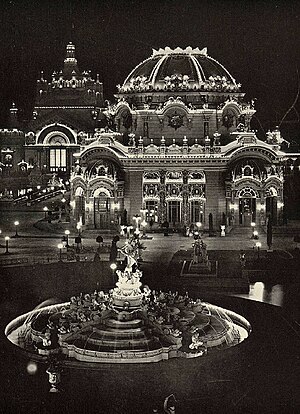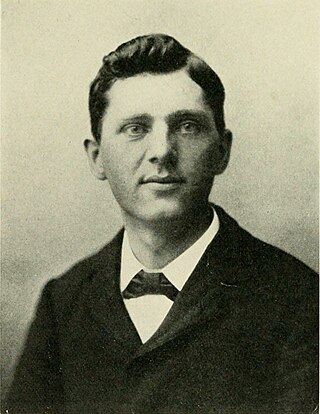
Leon F. Czolgosz was an American laborer and anarchist who assassinated president William McKinley on September 6, 1901, in Buffalo, New York. The president died on September 14 after his wound became infected. Caught in the act, Czolgosz was tried, convicted, and executed by the State of New York seven weeks later on October 29, 1901.

The Pan-American Exposition was a World's Fair held in Buffalo, New York, United States, from May 1 through November 2, 1901. The fair occupied 350 acres (0.55 sq mi) of land on the western edge of what is now Delaware Park, extending from Delaware Avenue to Elmwood Avenue and northward to Great Arrow Avenue. It is remembered today primarily for being the location of the assassination of United States President William McKinley at the Temple of Music on September 6, 1901. The exposition was illuminated at night. Thomas A. Edison, Inc. filmed it during the day and a pan of it at night.

Theodore Roosevelt Inaugural National Historic Site preserves the Ansley Wilcox House, at 641 Delaware Avenue in Buffalo, New York. Here, after the assassination of William McKinley, Theodore Roosevelt took the oath of office as President of the United States on September 14, 1901. A New York historical marker outside the house indicates that it was the site of Theodore Roosevelt's Inauguration.
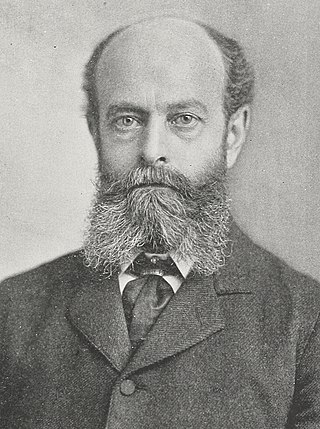
Matthew Derbyshire Mann was an American gynecologist and one of the surgeons who operated on President William McKinley after he was shot on the grounds of the Pan American Exposition on September 6, 1901, in Buffalo, New York, by anarchist Leon F. Czolgosz.

Niagara Square is a public square located at the intersections of Delaware Avenue, Court Street, Genesee Street, and Niagara Street in Buffalo, New York. It is the central hub of Joseph Ellicott's original radial street pattern that he designed in 1804 for the then village of New Amsterdam. It continues to be the nexus of downtown Buffalo.

The Buffalo History Museum is located at 1 Museum Court in Buffalo, New York, just east of Elmwood Avenue and off of Nottingham Terrace, north of the Scajaquada Expressway, in the northwest corner of Delaware Park.

William McKinley, the 25th president of the United States, was shot on the grounds of the Pan-American Exposition in the Temple of Music in Buffalo, New York, on September 6, 1901, six months into his second term. He was shaking hands with the public when anarchist Leon Czolgosz shot him twice in the abdomen. McKinley died on September 14 of gangrene caused by the wounds. He was the third American president to be assassinated, following Abraham Lincoln in 1865 and James A. Garfield in 1881.
The Grover Cleveland Golf Course is a historic golf course located in Buffalo, New York that hosted the 1912 U.S. Open that was founded as The Country Club of Buffalo. It is one of two courses owned by Erie County.

James Addison Johnson was an American architect known for his design of various architectural landmarks in Buffalo, New York, and his use of decorative work that many consider a foreshadowing of art deco design.

Edward Brodhead Green, very often referred to as E. B. Green, was a major American architect from New York State.

The Architecture of Buffalo, New York, particularly the buildings constructed between the American Civil War and the Great Depression, is said to have created a new, distinctly American form of architecture and to have influenced design throughout the world.

Edward Austin Kent was a prominent architect in Buffalo, New York. He died in the sinking of the RMS Titanic and was seen helping women and children into the lifeboats.
Esenwein & Johnnson was an architectural firm of Buffalo, New York.
Ellicott Development Co. is an American property management, leasing and development real estate firm based in Buffalo, New York and led by CEO William Paladino. The company's asset base includes residential, commercial, hotels, parking garages, and convenience stores. Ellicott Development Co.’s services include legal, administrative, financial, management, accounting, development, site selection, site assemblage, architectural design and drafting services, construction, leasing, maintenance, janitorial and security services.

The following events occurred in September 1901:

James Benjamin Parker was an African-American man most noted for attempting to stop Leon Czolgosz from assassinating President William McKinley.
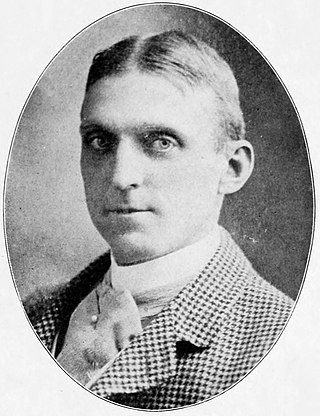
George Cary, was a major American architect from New York State known for his designs for the Pan-American Exposition of 1901 in Buffalo, New York.
Alice Russell Glenny (1858–1924) was an American painter, sculptor, and graphic artist who lived and worked in Buffalo, New York. Glenny was a fixture of the thriving artistic scene in Buffalo in the early twentieth century. From 1893-1894 and 1903–1904, she served as president of the Buffalo Society of Artists. She studied under top teachers, such as William Merritt Chase and Gustav Boulanger, in both the United States and France, and was considered in her time to be one of the city's top artists. Today, Glenny is best remembered for her Art Nouveau posters and magazine illustrations. Her posters were featured prominently in Buffalo's Pan-American Exposition of 1901, famous for being the location of the shooting of President William McKinley. She also regularly contributed illustrations to the Buffalo-Courier Express, one of the major newspapers in Buffalo at the time.

William Insco Buchanan was an American diplomat who spent much of his career in Latin America.
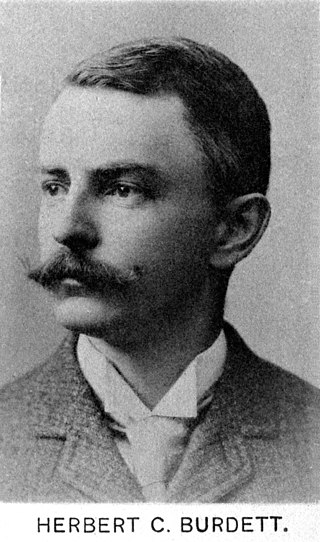
Herbert Channing Burdett (1855–1891) was an American architect trained in the office of Henry Hobson Richardson who, in a brief career, established himself as a successful designer of Shingle Style and Richardsonian Romanesque buildings in western New York. With his partner James Herbert Marling (1857–1895), Burdett designed several public buildings in Buffalo, New York and a number of residential properties for the leading citizens of Buffalo, Woodstock, Ontario and Burlington, Vermont. Owing to his premature death, Burdett is little remembered today outside those areas where his known buildings still survive.
